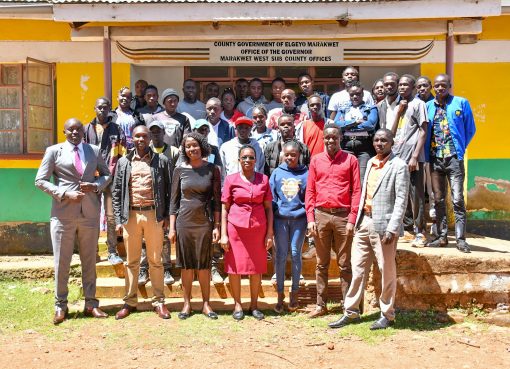29TH DECEMBER 2017, BY JOSEPH KIPKOECH
The manufacturing sector’s contribution to Kenya’s national wealth, technically referred as gross domestic product (GDP) has stagnated at about 10 per cent in a decade or so. In 2016, the sector’s share of GDP fell to 9.2 per cent, an indication that it grew at a slower pace than the economy.
The under-performance of the sector has been widely cited as the reason Kenya has failed to achieve the targeted sustainable annual 10 per cent growth in GDP from 2010 under the Vision 2030, the country’s long-term development blueprint. The best performance of the overall economy was in 2010 when GDP expanded by 8.4 per cent, dashing hopes of an upper middle-income economy in the next 12 years.
The economy has also struggled to create decent employment opportunities with 89.2 per cent of the 832, 900 jobs in 2016 coming from the informal sector. Only 85, 600 jobs were created in the formal sector in 2016. President Uhuru Kenyatta has strongly indicated that the promotion of the stagnant manufacturing sector will be a priority in his economic agenda during his second and final term in office. “Creating jobs and opportunities for our young population is also a top priority. In this regard, we will target manufacturing. As you know our manufacturing sector is the primary vehicle for the creation of decent jobs,”
Mr. Kenyatta said last year in his inauguration speech. “Over my term, we will grow and sustain this manufacturing sector, and raise its share of the national cake from nine to 15 per cent.”
The president has identified agro-processing, textiles and apparel, leather processing, making of construction materials innovation and IT, mining and extractives as key sub-sectors his administration will focus on.
Industrialization Cabinet Secretary Mr. Adan Mohamed says the country has laid the groundwork for accelerated growth in the manufacturing sector, citing the setting up of special economic zones and industrial parks in Machakos and Ruiru as well as the establishment of several manufacturing plants such as the East African Breweries in Kisumu. The industrial space for textiles and apparel development in Athi River has also been expanded with Sh3.1 billion set aside in the year 2016/17 financial year for the project.
As per its 10 -year transportation report, the ministry is also betting big on SMEs such as footwear and leather product manufacturing in Nairobi’s Kariakor market where shared facilities have been created.
The Kenya Association of manufactures (KAM), the sectors lobby group, said Kenya has capacity to spur industrial growth and development just like South Korea- a country whose economy was at par with Kenya at independence in 1963.
The Korea Republic focused on development of basic industries such as chemical fertilizers, cement, oil refinery, iron and steel as well as promotion of value-added exports under a five year plan from 1962. The East Asian tiger economy, which has the 11th highest GDP in the world, also invested heavily in science and technology and expanded agriculture and energy sectors, becoming one of the fastest growing economies in the world through 1990s.
Today, Korea is one of the world’s most industrialized and diversified economies with brands such as Samsung and LG Electronics dominating the sales across the world.
“Increasing the competitiveness of local industries is key in industrial growth,” KAM says in its 10- point agenda. “Increasing our manufacturing base is critical to job creation and economic growth as well as domestic and foreign investment,” KAM adds.
The lobby is, among others, rooting for development of stronger technical and trade-based skills to enhance labour productivity and sharpen the sectors’ competiveness. KAM chief executive Phyllis Wakiaga said the Jubilee administration should ensure laws and regulations are predictable, while countries should address multiple fees and licenses to attract and retain investments.
She also wants the 2013 Railway Development Levy, charged at 1.5 per cent of the value of imports, and the 2.5 per cent Import Declaration fees scrapped as they raise production costs for manufacturing firms.
Export Promotion Council chief executive Peter Biwott said the state is keen on promoting value-added exports as a way of emboldening the economy’s fundamentals. “What Kenya has really suffered from is a narrowing of products for exports. (But) We are at the right time because the country now is going to focus on manufacturing,” Mr. Biwott said.
“There’s need for provision of incentives, and we are coming up with export development fund which is a priority, so that we support these firms to diversify and enhance value addition,” he added.
Kenya is a signatory to the World Trade Organization’s Trade Facilitation Agreement, which came into force on February 22 this year after getting the mandatory support from two thirds of WTO members, binds the country to reforms aimed at reducing non-tariff barriers (NTBs) to trade.
The Industrialization Cabinet Secretary says since 2013, 20 NTBs have been resolved within East Africa, easing the movement of Kenyan goods to its neighbors. This, Mr. Mohamed notes, has resulted in growth of exports and creation of jobs.
The President said the country will vigorously pursue bilateral ties to meet its ambitious objectives.
“We shall reach out to our key trading partners to work with us to achieve a win-win outcome that enables Kenyans to get the most pout of their products,” Mr. Kenyatta said. “This will involve negotiations to open new international markets for our products, and to attract even more new investment,” he added.



